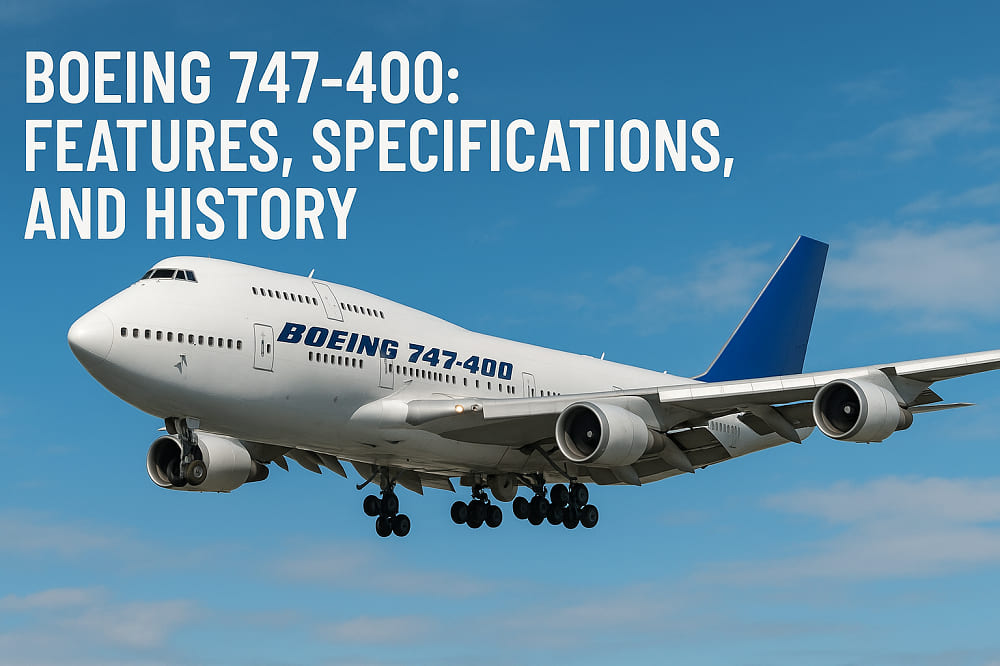Discover the remarkable Boeing 747-400, an engineering masterpiece that revolutionized international air travel. This comprehensive guide explores the aircraft’s innovative features, impressive specifications, and lasting impact on aviation history. Whether you’re an aviation enthusiast or simply curious about this iconic aircraft, you’ll find valuable insights into what makes the 747-400 truly special.
The Boeing 747-400 represents the pinnacle of aviation engineering, marking a significant evolution in the iconic 747 series. This long-range wide-body airliner combines cutting-edge technology with proven design principles, creating an aircraft that’s both innovative and reliable.
- Advanced aerodynamic features including winglets for improved fuel efficiency
- Streamlined cockpit design enabling two-pilot operation
- Enhanced long-range capabilities with high passenger capacity
- Significant cost savings through technological improvements
- Proven reliability in international route operations
Aircraft Engine Stands For Lease
Design and Features of the Boeing 747-400
The aircraft maintains the iconic 747 configuration while introducing revolutionary advancements. The stretched upper deck, inherited from the 747-300, combines with innovative winglets to create an aerodynamically superior aircraft. The elimination of the flight engineer position represents a significant technological leap, enabling more efficient two-pilot operations while maintaining the highest safety standards.
Exterior Design and Aerodynamics
The exterior design showcases aerodynamic innovation through several key features:
| Feature | Specification | Benefit |
|---|---|---|
| Winglets | 6-foot (1.8-meter) | Reduced drag, improved fuel efficiency |
| Wingspan | 211 feet 5 inches (64.4 meters) | Enhanced lift and stability |
| Length | 231 feet 10 inches (70.6 meters) | Optimal passenger/cargo capacity |
Interior Layout and Passenger Comfort
The interior design prioritizes passenger comfort and operational flexibility with various seating configurations:
- Three-class configuration – accommodates 416 passengers
- Two-class layout – seats up to 524 passengers
- Premium upper deck with exclusive seating options
- Enhanced cabin features including:
- Larger overhead bins
- Improved lighting systems
- Ergonomic seating design
- Advanced noise reduction technology
Specifications and Performance of the Boeing 747-400
The aircraft boasts impressive performance metrics, with a maximum takeoff weight (MTOW) of 396,895 kg (875,000 lb). Its design incorporates significant aerodynamic improvements that enhance both fuel efficiency and overall performance.
Engine Specifications and Fuel Efficiency
Airlines can choose from three powerful engine options:
- Pratt & Whitney PW4000 series – 57,100 pounds thrust (PW4056)
- General Electric CF6 series
- Rolls-Royce RB211 series
Range and Speed Capabilities
| Performance Metric | Specification |
|---|---|
| Maximum Cruising Speed | 939 km/h (507 knots) |
| Long-range Cruising Speed | 907 km/h (490 knots) |
| Range (PW-4000 engines) | 13,491 km (7,284 nautical miles) |
| Range (GE engines) | 13,444 km (7,259 nautical miles) |
| Range (Rolls-Royce engines) | 13,214 km (7,135 nautical miles) |
Capacity and Variants of the Boeing 747-400
The Boeing 747-400 stands as a testament to versatility in commercial aviation, offering multiple variants designed for diverse operational requirements. This remarkable aircraft has established itself as a cornerstone of long-haul travel and cargo operations, demonstrating exceptional adaptability across different market segments.
Passenger and Cargo Capacity
The aircraft’s passenger capacity demonstrates remarkable flexibility in seating configurations:
- Three-class layout – 416 passengers
- Two-class configuration – up to 524 passengers
- Custom luxury configurations available for specialized operations
| Cargo Area | Volume | Container Capacity |
|---|---|---|
| Forward Lower Hold | 79.3 m³ (2,800 ft³) | 16 LD-1/LD-3 containers |
| Aft Lower Hold | 69.4 m³ (2,450 ft³) | 14 LD-1/LD-3 containers |
| Bulk Cargo Space | 23.6 m³ (835 ft³) | Additional storage or 2 LD-1/LD-3 |
Different Variants and Their Uses
The 747-400 family encompasses several specialized variants:
- 747-400 Domestic – optimized for high-capacity short-haul routes, particularly in Japan, featuring no winglets for improved efficiency on shorter flights
- 747-400M Combi – unique dual-purpose configuration allowing simultaneous passenger and cargo transport on the main deck
- 747-400F Freighter – dedicated cargo variant combining the 747-200F fuselage with advanced 747-400 wing design
- Boeing Dreamlifter – heavily modified version for transporting large aircraft components
- 747 Supertanker – specialized adaptation for aerial firefighting operations
- Boeing YAL-1 – modified 747-400F serving as a testbed for high-energy laser weapon systems
Historical Development and Innovations of the Boeing 747-400
Launched in October 1985, the Boeing 747-400 marked a revolutionary advancement in aviation technology. This ‘high-tech jumbo’ distinguished itself from earlier ‘classic jumbo’ models through significant technological innovations, including a glass cockpit, efficient tail fuel tanks, and advanced engine systems.
Development Timeline and Milestones
The aircraft’s development progressed rapidly, with key achievements including:
- October 1985 – Official program launch
- April 29, 1988 – First development aircraft flight
- Mid-1989 – Resolution of early production challenges
- Remarkable delivery of all three engine variants within four months
Technological Innovations and Advancements
The 747-400 introduced several groundbreaking technologies:
- Two-crew digital flight deck with six CRT displays, eliminating the need for a flight engineer
- Advanced high-bypass turbofan engines with improved thrust and efficiency
- Full-authority digital engine control (FADEC) system for optimized performance
- Pioneering use of winglets in commercial aviation
- Recontoured wing/fuselage fairing for enhanced aerodynamics
- Modernized interior design for improved passenger comfort
The Legacy and Impact of the Boeing 747-400
The Boeing 747-400 represents a pinnacle achievement in aviation history, revolutionizing the commercial aircraft industry. This advanced variant of the original 747 emerged as the most successful model in the family, with an impressive 694 aircraft delivered throughout its production run. Its remarkable combination of increased range, improved fuel efficiency, and enhanced passenger comfort established new benchmarks in commercial aviation.
Influence on Aviation Industry
The 747-400’s impact on aviation has been transformative, introducing several groundbreaking innovations:
- Revolutionized long-haul operations with efficient and cost-effective routes
- Triple passenger capacity compared to contemporary jets
- Reduced cost per seat-mile for airlines
- Pioneered glass cockpit technology and two-pilot operations
- Established new standards for cockpit design and crew management
These innovations sparked industry-wide competition, encouraging other manufacturers to develop more efficient wide-body aircraft, ultimately leading to increased options and reduced fares for long-haul travelers.
Future Prospects and Successors
| Aircraft Type | Current Status | Key Features |
|---|---|---|
| 747-400 | Active in cargo operations | Large capacity, long range capability |
| 747-8 | Direct successor | Improved fuel efficiency, increased capacity |
| Boeing 777/787 | Modern alternatives | Enhanced efficiency, advanced passenger comfort |
While passenger variants are gradually being phased out in favor of more fuel-efficient twin-engine aircraft, the 747-400’s influence continues through its successors. The Boeing 747-8 carries forward its legacy, while modern aircraft like the 777 and 787 Dreamliner embody its spirit of innovation in long-range, high-capacity travel. Though the era of the 747-400 may be concluding, its impact on aviation design and operations will resonate for generations to come.
Read more:
- Boeing 707: History, Features, and Impact on Aviation
- Boeing 777: Features, Specifications, and Insights
- Boeing 737 Max: Latest Updates and Safety Information
- Boeing 737-900: Specifications, Features, and Seat Map
- Boeing 717: Specifications, Features, and Flight Experience
- Boeing 767: Specifications, Features, and Insights
- Boeing 737-700: Features, Specifications, and Seat Map
- Boeing 787-9: Features, Specifications, and Insights
- Boeing 767-400: Specifications, Features, and Seat Maps
- Boeing 777-200: Specifications, Features, and Seat Map

